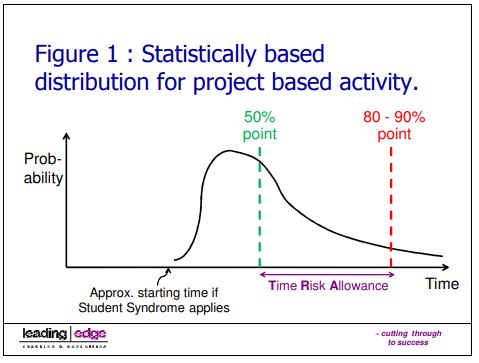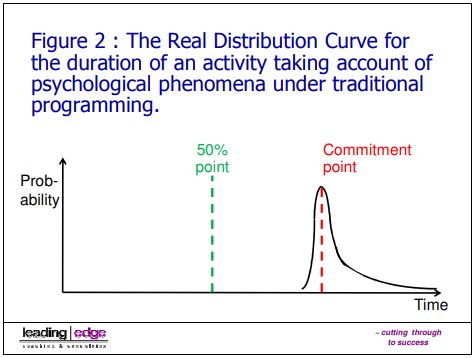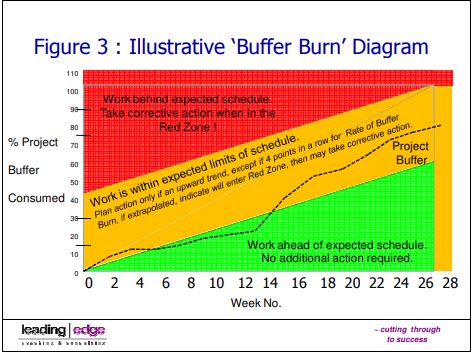Critical Chain project management and NEC3
Critical Chain project management and NEC3:
a Response to Glen Hide’s Article on Contractor’s Float in Programmes
Introduction
In the NEC eNews Issue 6 and the NEC users Newsletter Issue 43, Glenn Hide discussed ownership of float and time risk allowance. While I totally agree with his conclusions on the contractual ownership of float, I believe his comments on ‘Buffered programmes’ arise from a lack of knowledge of Critical Chain project management – a comparatively new method of planning and managing projects. This article attempts to educate the reader – be they a Contractor preparing a programme or a Project Manager having to accept it – on this methodology and its benefits and show that there is no contradiction with the NEC’s contractual terms.
The Problem with Traditional Programming
Traditional programming is based on the premise that for a project to finish on time, each operation and activity has to finish on time. Is this a realistic premise ? Let me ask you these questions to illustrate:
- Even if no identifiable risks occurs (as would be in a risk register), if there is an operation in your programme due to start in 3 months time, would you be willing to bet me £100 on it starting on time and finishing on time?
- What about an operation starting in 3 weeks time?
- What about one starting in 3 days time?
Or as the joke goes : how do engineers write fiction? They do a programme.
The reality is that for any operation, even in a controlled environment, there will be variation in its duration due to what is known as common cause variation : the summation of tiny variations which typically and on average occur for that operation.
The extent to which an operation is unique and in a different context will increase this variation. In construction, while most operations are not unique, they are done in a widely varying context : a different site located in different parts of the country, with different access to and inside the Site; different weather and physical conditions; different operations happening before, after and around them; and with many of them dependant on people (as opposed to being highly automated as per a factory).
Figure 1 showing this curve is given below and is typical for a project based operation.

Hence to pretend that any operation or activity will take a fixed amount of time could be viewed as delusional, yet that is the premise on which we programme and then try to manage projects. Or in NEC speak, to programme on this basis is unrealistic and a reason for rejection by the Project Manager under clause 31.3!
Statistical Phenomena
People are intuitively aware of this common cause variation : for instance, if I ask people a series of questions about likely durations of an imaginary operation, they will plot out a curve similar to that in Figure 1. One of these questions is “imagine you had a nasty boss / organisation above you, who will hold you to any time you give, penalise you if you exceed it, yet expect you to do it faster next time if you beat it. What time would you give ?”
They typically give a figure in the 80-90% range for the operation duration. Whatever duration they give, in NEC speak, the difference between the 50% point (where the operation has a 50% likelihood of finishing early and a 50% likelihood of finishing late) and 80-90% is the Time Risk Allowance, with the latter typically being about 50% longer than the 50% i.e. a third of the given duration for the operation is Time Risk Allowance. Compare the reality of this with the 1.7 days Time Risk Allowance given by Glenn in his article for a 14.3 day pipe laying operation.
Psychological Phenomena
Below are three commonly occurring psychological phenomena which follow on from this statistical phenomena:
- People rarely deliver early even when they can for two reasons:
- Future Fear (touched on previously) whereby if they deliver earlier than they said they would, next time the planner will demand that they deliver to this reduced timescale; and
- Parkinson’s Law, whereby work expands to fill the time allocated;
- People, if anything, deliver late due to Student Syndrome whereby people start an operation late in the belief that they have plenty of Time Risk Allowance. Unexpected common cause variation then occurs and they deliver late.
- Because the planner does not expect operation to be handed over early, he has not planned to take advantage of this scenario.
The first two points mean that in reality the distribution curve looks more like that in Figure 2 below. As a result of all three points, the overwhelming tendency is for project durations to increase, even when no identifiable risks occur. This is despite there already being an excess of Time Risk Allowance built into the programme!

The Solution
The programming and management solution is simple in terms of the mechanics:
- you amalgamate your Time Risk Allowance to the end of a ‘chain’ of operations to get the ‘Buffer’.
- you take advantage of early finishes, which should balance out late finishes.
- you measure the extent of and rate of ‘Buffer Burn’ along each chain of operations (see Figure 3 below as an example).
- depending on what these measures are telling you and because of Point 2, you only take corrective action when the trends clearly indicate that you will finish after the end of the Project Buffer.

The Advantages
Because late finishes are now balanced out by taking advantage of early finishes, your gain much greater certainty that your projects finish on time, rather than trend towards delay as per traditional programming.
A further advantage is that statistically you need less Buffer than the sum of the individual Time Risk Allowances. Consequently, you actually have shorter programmes in the first place.
Implementing the Solution
However, it is the culture change that is the difficult thing to achieve as you want those doing the work:
- To accept that there is inevitably variation in the duration of operations
- To give you aggressive, but realistic durations for their operations with their individual TRAs separated out to be put as Buffer.
- To start their operation as soon as the proceeding one finishes and to work hard and continuously on it till it is completed “without Defects which would either delay or be covered by immediately following work” (to quote option A clause 11.2 (27)).
To do this may well mean changes in how you motivate and reward people and subcontractors.
As a project manager or contractor, the hard thing to accept is that you are not holding people to their estimates (as they are only guesses). Instead, you are holding them to start their operation as soon as the proceeding one finishes and to work hard and continuously on it till finished.
The method can be enhanced by using techniques from the Last Planner TM system, as used on Heathrow Terminal 5 and the Channel Tunnel Rail Link, to minimise the causes of variation, leading to reduced operation duration, reduced time risk allowances and hence buffer.
The Benefits
Hundreds of companies from many sectors now use Critical Chain project management with widely reported benefits. Construction, despite being almost wholly project based, has been slow to take it up. In addition, companies implementing it are slow to publicise exactly how they are achieving competitive advantage.
Three case studies of construction companies from Spain indicate that project durations are typically reduced by between 20 and 25% with much greater certainty of delivering within stated timescales.
In Japan, from a small seminar in 2003, Critical Chain project management has rapidly been embraced both by industry and the Ministry of Land, Infrastructure & Transportation on whose projects its use has now become mandatory. It has resulted in a 7% increase in average profits and a 20% reduction in project durations, as well as cost savings for the Ministry.
Contractual Implications under the NEC
Initially, the only difference for a Contractor when putting together his programme is that the Time Risk Allowances are put at the end of each ‘chain’ of operations as ‘Buffer’, rather than attached to each operation. He will still contractually own this Buffer as he owns the Time Risk Allowance.
Once contractors and their subcontractors understand and have bought into running projects in this way, contractors should be able to programme to have progressively more terminal float (the difference between planned Completion as shown in the Accepted Programme and the contractual Completion Date) shown in their programmes. However, they own this terminal float, so do not suffer.
The only downside from a contractor’s point of view is that statistically you need less Buffer than the sum of the individual Time Risk Allowances. This means that when a compensation event occurs, he would be allowed less Time Risk Allowance under clause 63.6. However, this will only impact on him if it eats into the free float (or total float in Glenn’s terminology) and is a small price to pay for the reduced overall time and consequent increase in profit and competitiveness.
Summary
To re-iterate, I agree with Glenn Hide’s conclusions on ownership of float and time risk allowance. However, I believe his criticisms of ‘Buffered’ programmes are based on a lack of knowledge about Critical Chain project management.
In this article, I have attempted to give as simple as possible an explanation of the problems with traditional programming and how Critical Chain project management tries to address them, together with an indication of some examples of its successes. I have also examined the contractual implications and found that there is nothing under the NEC that does not allow for it. Instead, it is a matter of education, which is the purpose of this article.
Consequently, there are no contractual reasons why both employers and contractors cannot gain its advantages : shorter project programmes and greater certainty of delivering to this time scale, which should help reduce project costs for employers whilst improving profits both for contractors and their supply chain.